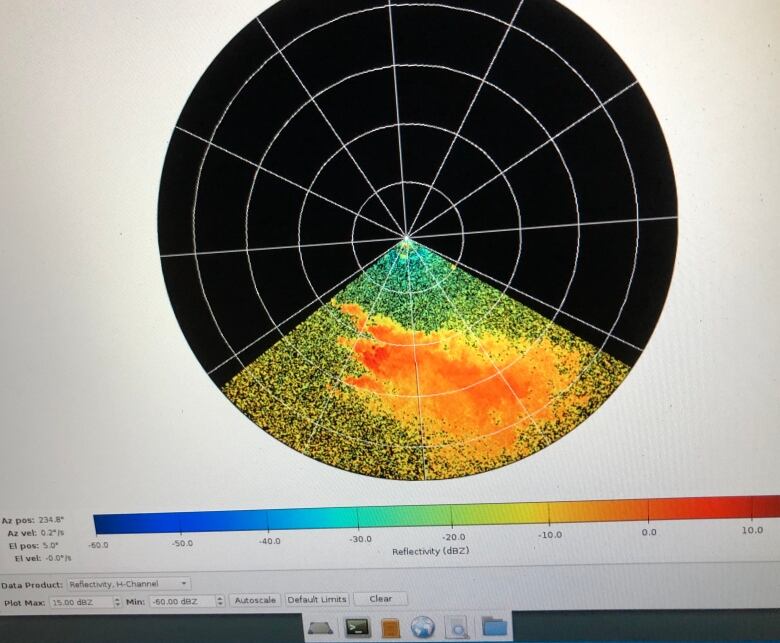New high-powered radar gives scientists a 3D view of wildfires in real time
The radar allows scientists to track activity inside fires to better predict and fight them

There's only so much you can learn about a wildfire by studying it from a distance. That's why an intrepid team of scientific fire chasers, equipped with a new high-powered, fire-probing radar system, head straight toward fires to collect valuable data up close as everyone but firefighters evacuate.
This team of fire chasers recently had front row seats for this season's destructive California wildfires.
"What we saw was pretty exciting because, as you pull into a fire incident, you try to make sure that everybody's safe — my whole team — that we set up in a safe-zone before we set up our instruments," said Craig Clements, a professor of meteorology and the director of the Fire Weather Research Laboratory at San Jose State University in California.
"What we observed was very big flames, a lot of erratic fire behaviour and very strong winds, so it was one of the more exciting deployments we've had."
Tracking those circulations and where the ash falls is really important to better understand the plume dynamics, which then could lead to better understanding of extreme fire behaviour.- Craig Clements, San Jose State University
Intense wildfires are on the rise with climate change. This is not news to many Canadians, or to the Australians and Californians suffering through extreme wildfire seasons right now.
This is adding urgency to the data Clements and his team are gathering.
"We need to be there to sample the winds and the meteorology and actually get a good handle on the fire behaviour because those data are needed to test the next generation fire behaviour models," he said.
Game-changing insight into fire behaviour
Over the last half-dozen years or so, Clements and his team have taken their portable fire research lab to more than 30 wildfires. They had used a laser-based system to peer inside the fires, but its capacity was limited. This fall, they got a new tool — an advanced radar system that could peer through heat, flame and smoke and provide unprecedented detail of the inner structure of wildfires.
It works much like a regular Doppler radar by measuring reflected signals to see particles in its path. But because of the new radar's wavelength, it can pick up the finer details of ash and embers much deeper into the wildfire plume than ever before.
"If you're used to looking at the weather radar on your iPhone or on The Weather Channel or something, you see the dark reds and purples; that's high reflectivity from heavy rain," said Clements. "In our case, the high reflectivity is lots of ash and potentially larger debris."

Clements said this new radar, which they use along with an infrared camera to measure temperature, is a game-changer, allowing fire-behaviour scientists to study the evolution of wildfires in real time.
"Tracking those circulations and where the ash falls is really important to better understand the plume dynamics, which then could lead to better understanding of extreme fire behaviour."
Looking right into the heart of the fire
Just as the New Horizons spacecraft gave us a glimpse of the dwarf planet Pluto's surface unlike the world had never seen, Clements said with their new radar, "We're seeing [internal fire] structures that we've never been able to measure before."
For example, he described what his instruments picked up in the California Kincade fires a few weeks ago, which were driven by extreme winds.
"What we're seeing are these reflectivity cores just punching up through the plume and then kind of being spit out the downwind side. And so that's where the ash would fall and potentially start new fires with spot fires."

He said there are really two types of fires — fires where the plume either goes straight up or sideways.
When there's not a lot of ambient wind, the plumes often shoot straight up, "so it's the heat of the fire that's actually driving the circulation in the plume."
But when there's a lot of wind, he said "the plumes are tilted over," and become more shallow.
"What that does is it causes the embers not to go straight up, but they go horizontally and they can go farther downwind. That's one hypothesis," added Clements.
Research tool could also help fight fires
Clements said while they're using these tools to gather crucial data to better understand and predict fire behaviour, the fact they can see into the heart of wildfires in real time could also be extremely useful to firefighters on the ground.
"These tools can easily be adapted for fire operations around the world," said Clements.
"One of the things that we're proposing to fire management agencies, not only in the U.S. but around the world, is that using operational meteorological observations, such as radar networks or mobile radars such as we have, these data can be used for fire managers to better understand the fire environment."
